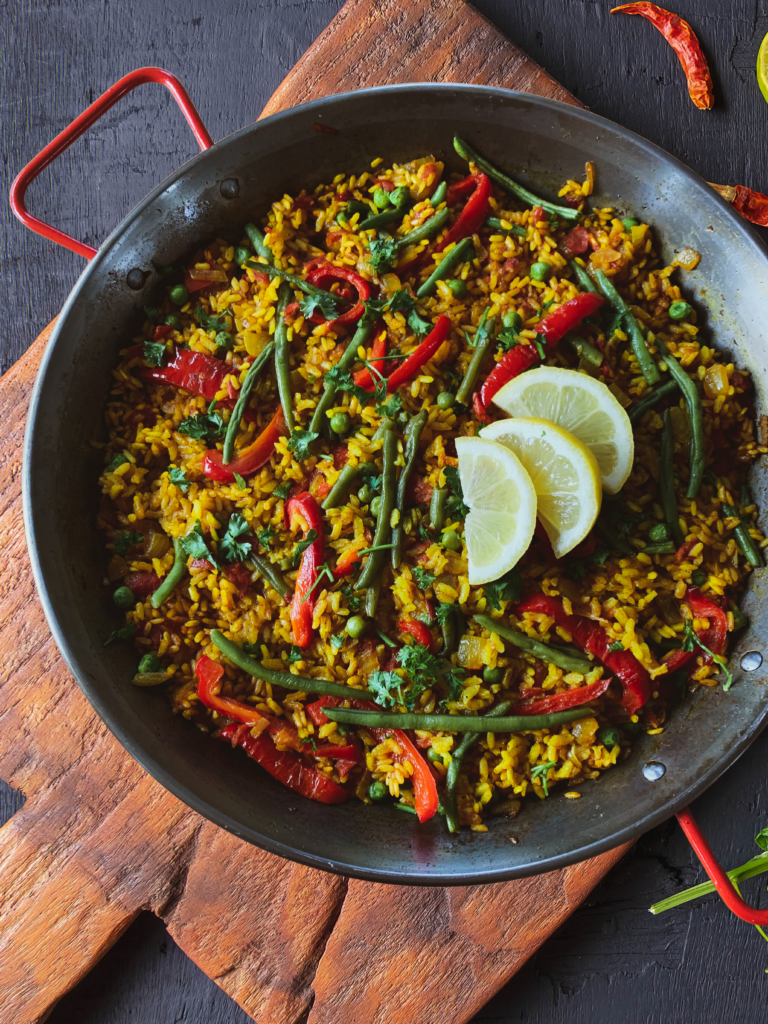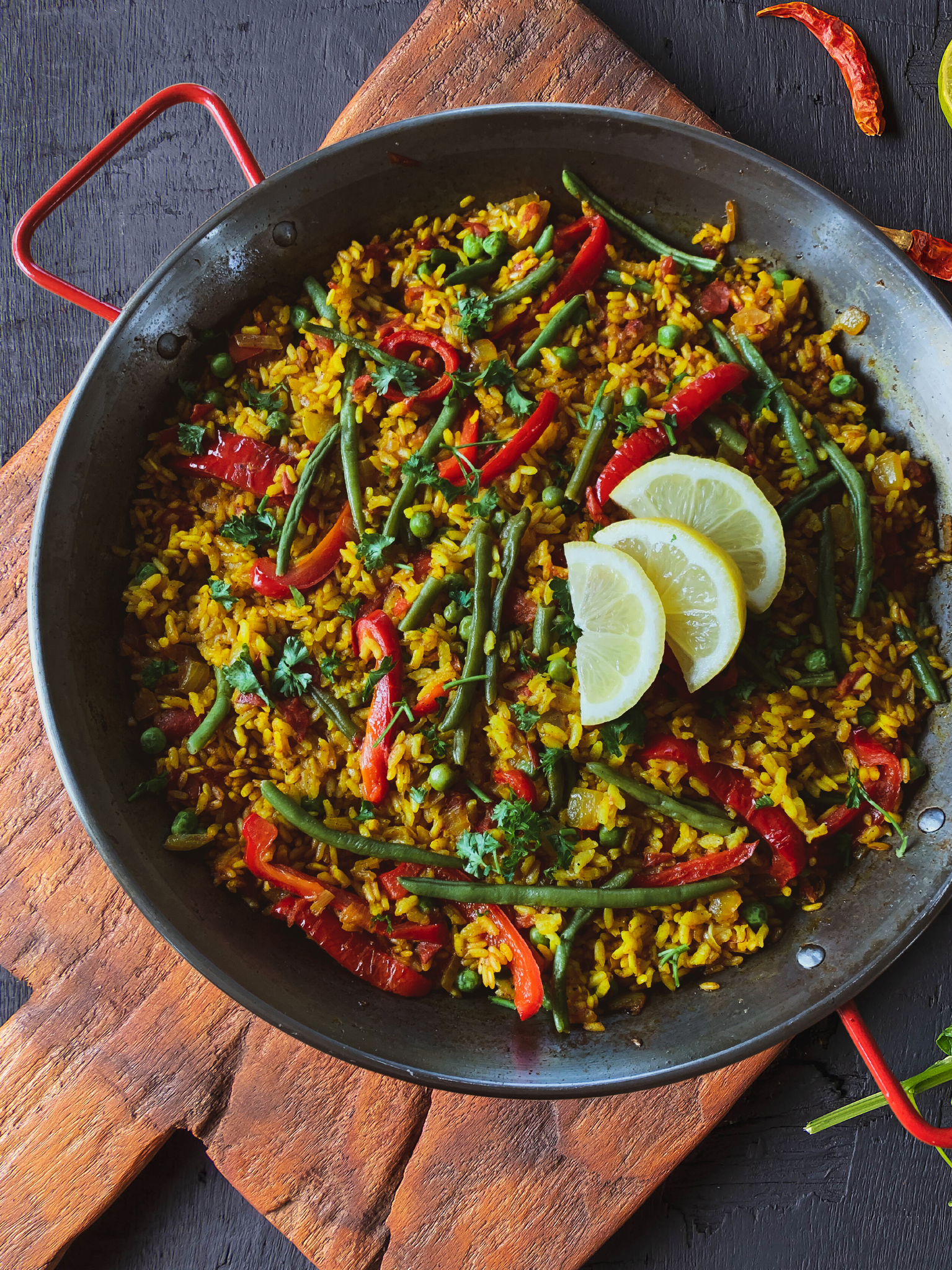The first time I had paella was in Mexico, and my parents became absolutely obsessed with it. Their favourite version is what is known as “paella mixta”, which refers to a mixed paella, with combinations of meat and seafood and is typically not known to be as traditional. This Spanish Vegetable Paella uses traditional techniques and includes seasonal ingredients to honour the original Paella Valenciana while being 100% vegan.

My favourite thing about paella is the delicious additions of seasonal vegetables which take on a TON of flavour from the saffron and spice rich broth. Try it! You won’t be disappointed.
What is Paella?
Paella is named after the traditional “frying pan” used to cook the dish. The large and shallow traditional pan is traditionally used over an open fire, giving it a smoky flavour that we emulate with smoked paprika here. Using the traditional pan is also what gives the dish the “socarrat”. Paella is typically served as a communal dish.
Traditionally, paella was made with a local variety of rice in Valencia, but most commonly people use Bomba rice – a short grain variety grown in Spain that does not get sticky when cooked. I use Arborio rice in this recipe as a more affordable alternative (and locally available), but it does have a tendency to get sticky if disturbed while cooking. Use what you have available, but try to use a short-grain rice if possible!
Paella was invented in the Valencia region of Spain, and the original recipe (called Paella Valenciana) is traditionally made with rabbit, chicken, lima beans and green beans. Seasonal availability of ingredients may have affected what was used.
Paella de marisco uses seafood rather than meat, and may omit the beans and vegetables.
Paella mixta refers to a mixed paella with meat and seafood.
Many other local variations exist throughout Spain and the Mediterranean.
What is Socarrat?
The socarrat is the caramelized and browned rice at the bottom of the paella dish, and is known as the most important and popular part of paella. The socarrat is deeply flavourful, and you will find yourself fighting over the crispy caramelized rice at the bottom of the pan.
About Saffron
The yellow colour in paella comes from the use of Saffron, the world’s most expensive spice! Saffron comes from the saffron crocus stigmas. With only 3 per flower, a LOT of flowers are needed to harvest a small amount of saffron. Saffron is known for its floral, earthy, sweet, and bitter flavours. It’s very distinct, but turmeric or calendula can be substituted for a similar colour and flavour profile.
Substituting Vegetables
Feel free to mix and match what you have seasonally available – one of my favourite variations on this recipe is using thinly sliced (on top) or diced squash (in the rice).
Any time you are adding a watery vegetable, you need to cook it before everything else to release water before you add it in later on. Adding additional liquid to the paella, even with adding a single tomato, can have huge implications on the final product.
But don’t let that deter you! Simply cook out the liquid or reserve 1/4 cup of the liquid in the recipe to add later if needed.
To Make Spanish Vegetable Paella
Prep the broth
Start by preparing the both by bringing the water to a boil, then add the “chicken” broth cubes, bay leaf, and saffron. Turn off the heat and let the ingredients sit. Remove the bay leaf and discard after 5 minutes.
With pre-made broth: bring it to just below a simmer and add the bay leaf and saffron before covering and and letting it sit for 5 minutes. Discard the bay leaf after 5 minutes.
Meanwhile, prep all the ingredients, as the dish will come together quickly.



Cook the Vegetables
Heat the paella pan and oil over medium heat for 15-30 seconds then add the onion and garlic. Sauté, stirring constantly to avoid burning the garlic, until they turn translucent and just begin to brown (about 3- 5 minutes). Add the tomatoes and cook for an additional 2 minutes, stirring occasionally.



Add the paella seasoning, smoked paprika, paprika, cayenne, and black pepper. Stir well and cook for 1 minute before adding the rice. Toast the rice for a few minutes until it turns white and pearly. Add the white kidney beans, half the bell peppers, peas, and green beans. Stir, then add the broth and salt to taste. Do not stir after this point.
Cook the Paella
Turn the burner up to high heat and bring to a boil. Boil the paella on high or medium-high, uncovered, for 10 minutes. Then reduce the heat to low and cook an additional 6 minutes uncovered. Once it is done simmering uncovered, sprinkle the remaining bell peppers, green beans, and peas over top and any other additional desired vegetables. Cover with a lid or large pieces of tinfoil and cook another 5 minutes over low heat. Then turn off the heat and let it sit for 5 minutes undisturbed.



Remove the lid or tinfoil and check for doneness. You can use a fork to “peek” at the bottom to check if there’s a socarrat and if any extra liquid remains. If it needs more time, turn the heat back on and cover for a few more minutes. If for some reason your rice isn’t cooked and there’s no more water, add a little bit more. Turn the heat up to high for 30 – 90 seconds if you want a bit more of a socarrat to form on the bottom, but be very careful not to burn it!


Serve this Spanish vegetable paealla with a squeeze of fresh lemon juice and a sprinkle of fresh parsley. Traditionally this is a communal dish, but you may choose to scoop and serve individual portions. Enjoy!
If you enjoyed this recipe, try making my Vegan Creole Jambalaya.

Authentic Spanish Vegetable Paella (Vegan)
Ingredients
Equipment
Method
- Prepare the both by bringing the water for the broth (or pre-made broth) to a boil, then add the “chicken” broth cubes, bay leaf, and saffron. Turn off the heat and let the ingredients sit. Remove the bay leaf and discard after 5 minutes.
- Prepare all the ingredients, as the dish will come together quickly.
- Heat the paella pan and oil over medium heat for 15-30 seconds then add the onion and garlic. Sauté, stirring constantly to avoid burning the garlic, until they turn translucent and just begin to brown (about 3- 5 minutes). Add the tomatoes and cook for an additional 2 minutes, stirring occasionally.
- Add the paella seasoning, smoked paprika, paprika, cayenne, and black pepper. Stir well and cook for 1 minute before adding the rice. Toast the rice for a few minutes until it turns white and pearly. Add the white kidney beans, half the bell peppers, peas, and green beans. Stir, then add the broth and salt to taste. Do not stir after this point.
- Turn the burner up to high heat and bring to a boil. Boil the paella on high, uncovered, for 10 minutes. Then reduce the heat to low and cook an additional 6 minutes uncovered. Once it is done simmering uncovered, sprinkle the remaining bell peppers, green beans, and peas over top and any other additional desired vegetables. Cover with a lid or large pieces of tinfoil and cook another 5 minutes over low heat. Then turn off the heat and let it sit for 5 minutes undisturbed.
- Remove the lid or tinfoil and check for doneness. You can use a fork to “peek” at the bottom to check if there’s a socarrat and if any extra liquid remains. If it needs more time, turn the heat back on and cover for a few more minutes. If for some reason your rice isn’t cooked and there’s no more water, add a little bit more. Turn the heat up to high for 30 – 90 seconds if you want a bit more of a socarrat to form on the bottom, but be careful not to burn it!
- Serve with a squeeze of fresh lemon juice and a sprinkle of fresh parsley. Traditionally this is a communal dish, but you may choose to scoop and serve individual portions. Enjoy!

Recent Comments